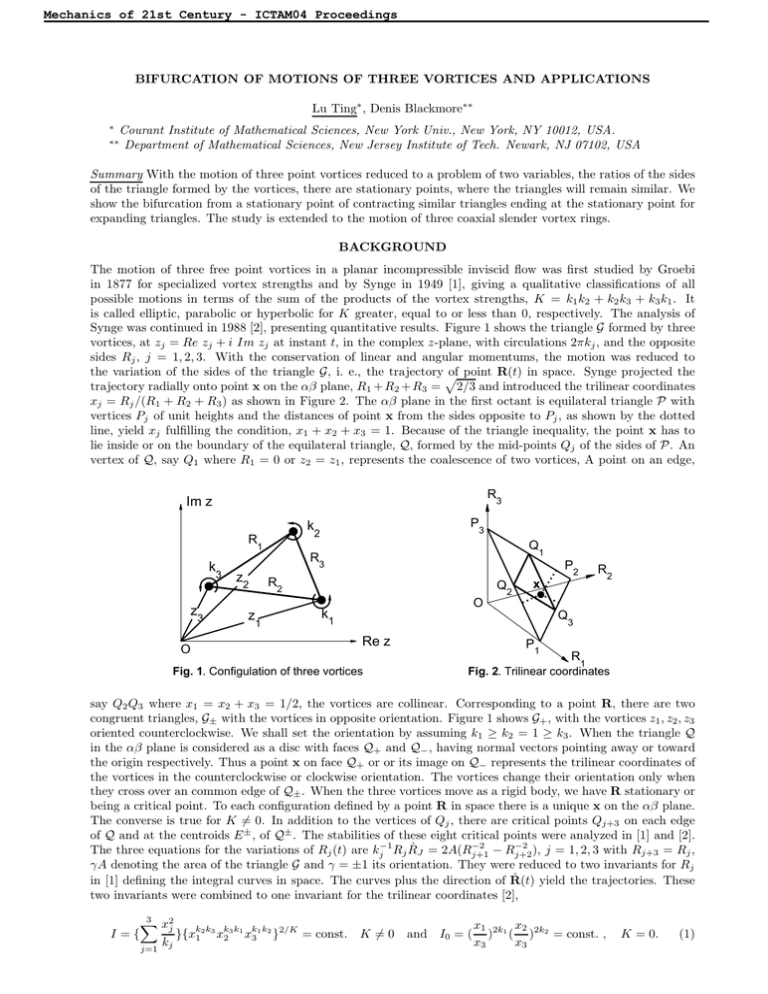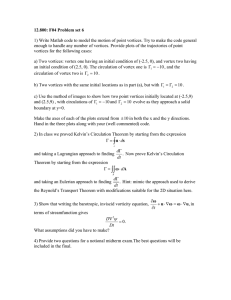BIFURCATION OF MOTIONS OF THREE VORTICES AND APPLICATIONS Lu Ting
advertisement

Mechanics of 21st Century - ICTAM04 Proceedings
BIFURCATION OF MOTIONS OF THREE VORTICES AND APPLICATIONS
Lu Ting∗ , Denis Blackmore∗∗
∗
Courant Institute of Mathematical Sciences, New York Univ., New York, NY 10012, USA.
Department of Mathematical Sciences, New Jersey Institute of Tech. Newark, NJ 07102, USA
∗∗
Summary With the motion of three point vortices reduced to a problem of two variables, the ratios of the sides
of the triangle formed by the vortices, there are stationary points, where the triangles will remain similar. We
show the bifurcation from a stationary point of contracting similar triangles ending at the stationary point for
expanding triangles. The study is extended to the motion of three coaxial slender vortex rings.
BACKGROUND
The motion of three free point vortices in a planar incompressible inviscid flow was first studied by Groebi
in 1877 for specialized vortex strengths and by Synge in 1949 [1], giving a qualitative classifications of all
possible motions in terms of the sum of the products of the vortex strengths, K = k1 k2 + k2 k3 + k3 k1 . It
is called elliptic, parabolic or hyperbolic for K greater, equal to or less than 0, respectively. The analysis of
Synge was continued in 1988 [2], presenting quantitative results. Figure 1 shows the triangle G formed by three
vortices, at zj = Re zj + i Im zj at instant t, in the complex z-plane, with circulations 2πkj , and the opposite
sides Rj , j = 1, 2, 3. With the conservation of linear and angular momentums, the motion was reduced to
the variation of the sides of the triangle G, i. e., the trajectory p
of point R(t) in space. Synge projected the
trajectory radially onto point x on the αβ plane, R1 + R2 + R3 = 2/3 and introduced the trilinear coordinates
xj = Rj /(R1 + R2 + R3 ) as shown in Figure 2. The αβ plane in the first octant is equilateral triangle P with
vertices Pj of unit heights and the distances of point x from the sides opposite to Pj , as shown by the dotted
line, yield xj fulfilling the condition, x1 + x2 + x3 = 1. Because of the triangle inequality, the point x has to
lie inside or on the boundary of the equilateral triangle, Q, formed by the mid-points Qj of the sides of P. An
vertex of Q, say Q1 where R1 = 0 or z2 = z1 , represents the coalescence of two vortices, A point on an edge,
R3
Im z
R1
k
3
z3
O
P3
k2
Q1
R3
z2
z1
P2
R2
Q2
x
R2
O
k1
Q3
Re z
Fig. 1. Configulation of three vortices
P1
R1
Fig. 2. Trilinear coordinates
say Q2 Q3 where x1 = x2 + x3 = 1/2, the vortices are collinear. Corresponding to a point R, there are two
congruent triangles, G± with the vortices in opposite orientation. Figure 1 shows G+ , with the vortices z1 , z2 , z3
oriented counterclockwise. We shall set the orientation by assuming k1 ≥ k2 = 1 ≥ k3 . When the triangle Q
in the αβ plane is considered as a disc with faces Q+ and Q− , having normal vectors pointing away or toward
the origin respectively. Thus a point x on face Q+ or or its image on Q− represents the trilinear coordinates of
the vortices in the counterclockwise or clockwise orientation. The vortices change their orientation only when
they cross over an common edge of Q± . When the three vortices move as a rigid body, we have R stationary or
being a critical point. To each configuration defined by a point R in space there is a unique x on the αβ plane.
The converse is true for K 6= 0. In addition to the vertices of Qj , there are critical points Qj+3 on each edge
of Q and at the centroids E ± , of Q± . The stabilities of these eight critical points were analyzed in [1] and [2].
−2
−2
− Rj+2
), j = 1, 2, 3 with Rj+3 = Rj ,
The three equations for the variations of Rj (t) are kj−1 Rj ṘJ = 2A(Rj+1
γA denoting the area of the triangle G and γ = ±1 its orientation. They were reduced to two invariants for Rj
in [1] defining the integral curves in space. The curves plus the direction of Ṙ(t) yield the trajectories. These
two invariants were combined to one invariant for the trilinear coordinates [2],
I ={
3
X
x2j
j=1
kj
}{xk12 k3 x2k3 k1 x3k1 k2 }2/K = const. K 6= 0
and I0 = (
x1 2k1 x2 2k2
= const. ,
) ( )
x3
x3
K = 0.
(1)
Mechanics of 21st Century - ICTAM04 Proceedings
When we set the origin of αβ
√ plane at the vertex Q3 the α-axes along Q3 P2 amd β-axis along Q3 P3 , we have
β = x3 and α = (x2 − x1 )/ 3. From the above invariants and the direction of ẋ or Ṙ, the trajectories of x in
the αβ plane were presented in [2] for various values of kj ’s for the elliptic, parabolic and hyperbolic cases.
For the parabolic case, with k3 = −k1 k2 /(k1 + k2 ) < 0, in addition to the eight critical points x corresponding
to those of R mentioned before, there are stationary points x along an arc in Q+ from critical point Q4 on the
edge Q2 Q3 passing through the centroid E to point Q5 on Q3 Q1 , and also on the image of the arc in Q− . A
point x in the segment Q4 E (EQ5 ) represents expanding (contracting) similar triangles G+ . For the image in
Q− , we interchange expanding and contracting for G− The contraction of similar triangles to the final collision
of three vortices looks like an interesting solution but the solution was shown to be unstable in [2] while the
expanding one are stable. Now we shall study the deviation or bifurcation from a contracting similar solution
due to instability.
CURRENT RESEARCH
For a parabolic case, the invariant I0 in (1) decreases from ∞ at the vertex Q3 where β = x3 = 0 to 1 at the
centroid E, β = 1/2 and finally to 0 at the vertex Q1 or Q2 where β = 1. The arc Q4 EQ5 in Q+ , the loci of
stationary points, is defined by H = k2 x21 + k1 x22 − (k1 + k2 )β 2 = 0. Crossing the arc from below, H changes sign
from negative to positive. Along the arc, H = 0, the invariant I0 decreases from its maximum at E towards its
end points. With k1 > k2 , we have I0 (E) = 1 > I0 (Q4 ) > I0 (Q5 ). The vertex Q3 is a center and the invariant
curves move away from Q3 as I0 decreases from ∞ to 1, with the curve I0 = 1 tangent to the arc H = 0 at E
from below. The trajectory or the separatrix from Q4 lies above the arc H = 0 and ends on the arc at point
S4 between E and Q5 . The separatrix from Q5 lies above that from Q4 , across over the edge Q2 Q3 at point
S5 and return to Q5 along the image of S5 Q5 in Q− . The unstable branch EQ5 is partitioned by point S4
to two segments. For a point x in the unstable segment ES4 , the trajectory bifurcates from the point along
I0 ∈ (I0 (Q4 ), 1) above the arc with x1 increasing while x2 decreasing, ending at a point in the stable segment
Q4 E of the arc representing stable expanding triangle G. For a point x in the unstable segment S4 Q5 , the
trajectory bifurcates from the point along I0 ∈ (I0 (Q5 ), I0 (Q4 )) above the arc with x2 decreasing to and then
crossing over the edge Q2 Q3 above point Q4 and returning along the image trajectory to x in stable segment
S4∗ Q5 in Q− . For a point x in the entire unstable segment EQ5 , the trajectory bifurcates along I0 ∈ (I0 (Q5 ), 1)
below the arc with x1 decreasing to and then crossing over the edge Q3 Q1 to Q− and ending at the image of
x in the stable segment E ∗ S5 . Similarly, we can trace the trajectories bifurcating from the unstable segment
Q4 E ∗ in Q− for I0 ∈ (I0 (Q4 ), 1). Thus completes the description of the trajectories for I0 ∈ (I0 (Q5 ), 1) in Q± .
Note that the centroid E (also E ∗ ) is unstable and looks like a saddle point below the arc H = 0 but like a
center above.
In addition to the above analyses, bifurcations of three vortex motions are also studied using a Hamiltonian
approach thereby providing further insights into the nature of the dynamics. As is well known, the governing
equations of motion of three vortices in a plane can be written in a three-degree-of-freedom Hamiltonian form.
This system has three independent integrals in involution, including the Hamiltonian function H, and is therefore
completely integrable. Two of these integrals can be used to reduce the number of degrees-of-freedom of the
system by two. By choosing the reduction properly, this system can be used to obtain the bifurcation results
described above and also provide some additional information concerning the motions.
The planar motion of three vortices serves as the leading order approximation of three slender coaxial vortex
rings in a meridian plane [3] having radii much larger than the distances between the rings, The approach was
used in [4] to analyze certain qualitative features of the motion of three coaxial vortex rings. In particular, they
showed, using the KAM and Poincaré-Birkhoff theorems, for vortex strengths having the same sign (the elliptic
case), there is a region of initial positions of positive area in a meridian plane for which the relative motion of
the rings is quasiperiodic on invariant tori or periodic. A similar formulation shall be employed to investigate
the bifurcations of motions of three coaxial vortex rings in the parabolic case.
References
[1] Synge, J. I.: On the Motion of Three Vortices. Can. J. Math. 1: 257-270, 1949.
[2] Tanvantzis J., Ting L.: The Dynamics of Vortices Revisited. Phys. Fluids 31: 1392-1409, 1988.
[3] Ting L., Klein R., Viscous Vortical Flows. Lecture Notes in Physics 374, Springer-Verlag, NY 1991.
[4] Blackmore D., Knio O., KAM Theory Analysis of the Dynamics of Three Coaxial Vortex Rings. Physica D,
140: 321-348 2000.
<< session
<< start



